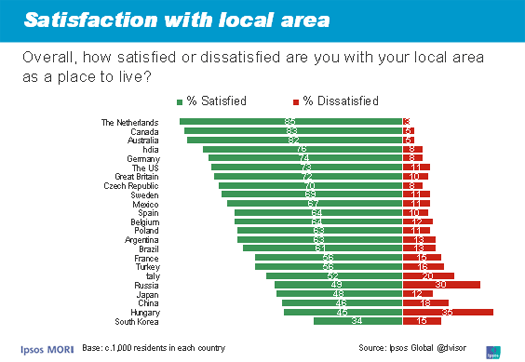One world, many places
Ipsos Social Research Institute Measures 23 Countries and finds Netherlands (85%), Canada (83%), Australia (82%), India (76%), Germany (74%) and US (73%) on Top. South Korea (34%), Hungary (45%), Japan (46%), China (48%) and Russia (49%) on Bottom.
The Ipsos Social Research Institute today released a major report which measures how satisfied or dissatisfied residents in 23 countries around the world are with their local area as a place to live and what top three priorities each want for improving their communities. The results show that residents of the Netherlands (85%), Canada (83%), Australia (82%), India (76%), Germany (74%) and the US (73%) had the world's residents who were the most satisfied with their local communities compared to residents in South Korea (34%), Hungary (45%), Japan (46%) and Russia (49%) who were the least satisfied with their local area were they live. Bobby Duffy, Director of the Ipsos Social Research Institute said: "During a global economic crisis it is easy to forget that how people experience their local areas day-to-day has a huge impact on their quality of life."
| 160How Satisfied They Are With Their Local Area As A Place To Live... | |
|---|---|
| 160Netherlands | 16085% |
| 160Canada | 16083% |
| 160Australia | 16082% |
| 160India | 16076% |
| 160Germany | 16074% |
| 160United States | 16073% |
| 160Great Britain | 16072% |
| 160Czech Republic | 16070% |
| 160Sweden | 16069% |
| 160Mexico | 16067% |
| 160Spain | 16064% |
| 160Belgium | 16064% |
| 160Poland | 16063% |
| 160Argentina | 16061% |
| 160Brazil | 16056% |
| 160France | 16056% |
| 160Turkey | 16056% |
| 160Italy | 16052% |
| 160Russia | 16049% |
| 160Japan | 16048% |
| 160China | 16046% |
| 160Hungary | 16045% |
| 160South Korea | 16034% |
Residents Indicate Top three Priorities for Local Area Improvement... When asked to indicate the top three priorities for improving their local area, many are consistent across the world: job prospects, clean streets, the level of crime and public transport. And the research also shows that county diversity is no barrier to finding local similarity. For example, a road/pavement repair is the number one priority in Belgium, Poland, Russia, Canada and India. But there are clear differences too. For example, in Britain activities for teenagers is the number one issue (the only country where this is the case), in Brazil it's health services and in China it's pollution that residents rank as their number one priorities for local improvement. "Our study shows how much satisfaction with local areas varies across countries - but also how consistent many of the concerns are. Global citizens are worried about the economy and jobs in particular, but also some relatively small things like clean streets." Mr. Duffy said. "There are also some significant differences in emphasis between countries -and we can learn a lot about our own national priorities by making these international comparisons." he concluded.
| Top Priorities For Improving Local Areas | |||
|---|---|---|---|
| Country | Priority 1 | Priority 2 | Priority 3 |
|
All |
Job prospects (42%) |
Road and pavement repairs (39%) |
Wage levels and cost of living (37%) |
|
Europe |
160 |
160 |
160 |
|
Belgium |
Road and pavement repairs (44%) |
Public transport (36%) |
Job prospects (34%) |
|
The Czech Republic |
Job prospects (48%) |
Road and pavement repairs (42%) |
Wage levels and cost of living (41%) |
|
France |
Job prospects (55%) |
Wage levels and cost of living (43%) |
Public transport (37%) |
|
Germany |
Job prospects (28%) |
Activities for teenagers (27%) |
Road and pavement repairs (24%) |
|
Great Britain |
Activities for teenagers (39%) |
Road and pavement repairs (37%) |
Job prospects (37%) |
|
Hungary |
Job prospects (73%) |
Wage levels and cost of living (67%) |
Road and pavement repairs (66%) |
|
Italy |
Public transport (50%) |
Job prospects (49%) |
Road and pavement repairs (44%) |
|
The Netherlands |
Level of crime (25%) |
Affordable housing (23%) |
Road and pavement repairs (20%) |
|
Poland |
Road and pavement repairs (59%) |
Wage levels and cost of living (54%) |
Job prospects (53%) |
|
Russia |
Road and pavement repairs (76%) |
Affordable housing (69%) |
Wage levels and cost of living (68%) |
|
Spain |
Affordable housing (51%) |
Job prospects (50%) |
Wage levels and cost of living (42%) |
|
Sweden |
Job prospects (49%) |
Level of crime (39%) |
Affordable housing (38%) |
|
Turkey |
Level of crime (41%) |
Level of pollution (41%) |
Traffic congestion (41%) |
|
North America |
160 |
160 |
160 |
|
Canada |
Road and pavement repairs (42%) |
Job prospects (38%) |
Affordable housing (32%) |
|
The United States |
Job prospects (49%) |
Wage levels and cost of living (42%) |
Road and pavement repairs (36%) |
|
Latin America |
160 |
160 |
160 |
|
Argentina |
Level of crime (68%) |
Road and pavement repairs (65%) |
Clean streets (62%) |
|
Brazil |
Health services (62%) |
Job prospects (56%) |
Level of crime (56%) |
|
Mexico |
Level of crime (60%) |
Road and pavement repairs (55%) |
Clean streets (55%) |
|
Latin America |
160 |
160 |
160 |
|
Australia |
Level of crime (36%) |
Road and pavement repairs (35%) |
Job prospects (33%) |
|
China |
Level of pollution (58%) |
Traffic congestion (48%) |
Wage levels and cost of living (40%) |
|
India |
Road and pavement repairs (54%) |
Level of pollution (52%) |
Clean streets (52%) |
|
Japan |
Level of crime (21%) |
Public transport (17%) |
Job prospects (17%) |
|
South Korea |
Public transport (33%) |
Affordable housing (33%) |
Level of pollution (32%) |
|
Source: Ipsos Global @dvisor |
|||

Technical Note
This data is taken from the sixth wave of the Ipsos Global @dvisor, an online survey of members of the public aged 18-64 across 23 countries. The countries include: Argentina, Australia, Belgium, Brazil, Canada, China, France, Germany, Hungary, India, Italy, Japan, Mexico, Poland, Russia, South Korea, Spain, Sweden, the Czech Republic, the Netherlands, Great Britain, the United States and Turkey.
For this wave, 23,673 interviews were carried out between November 2009 and January 2010. Internet Representation is balanced by age, gender, city population and education levels, with minor added weights applied. Approximately 1000+ individuals participated on a country by country basis via the Ipsos online panel, representing a +/-3.1% margin of error at the 95% confidence level.



